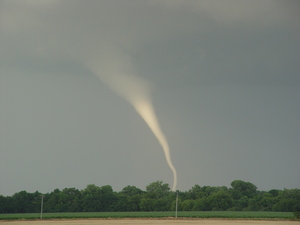Tornadoes are one of nature’s most devastating phenomena. According to the National Oceanographic and Atmospheric Agency (NOAA), an average year in the United States sees 1000 tornadoes claim approximately 80 lives, causing over 1500 serious injuries and millions of dollars of property damage.
We can’t prevent tornadoes, although modern forecasting techniques now provide adequate warnings to prevent loss of life, if individuals take the steps to protect themselves and their families. Take the following steps to prepare for a tornado:
1. Evaluate your risk. If you like in Nebraska or Kansas, preparing for tornadoes should take a high priority. If you live on the coast, prepare for hurricane but keep other possible disasters, like tornadoes, in mind as you plan.
2. Plan for at least three days on your own after the tornado strikes. Even the best prepared emergency response teams will require time to organize resources and personnel, assemble search teams, locate search and rescue dogs and heavy equipment, and there’s no guarantee they’ll find you first.
3. What’s your wind-safe shelter? Be realistic in deciding whether your home provides a tornado-safe shelter. A sturdy basement is usually safe; plan to shelter in the strongest section, near concrete walls or iron plumbing stacks to support a building collapse. A separate root cellar or tornado shelter is good, but be sure the door is sturdy enough not to be ripped off in high winds. Your local fire department will probably be willing to evaluate your shelter. If your home doesn’t offer an adequate tornado shelter, locate the nearest public shelter. Determine in advance if the shelter will allow you to bring your pet; if not, plan a place to keep him safe and confined during the storm. Don’t risk your life spending precious moments trying to protect your pet!
4. Stock your personal tornado shelter. The government has some suggestions for a basic emergency preparedness kit: http://www.ready.gov/america/getakit/index.html . To prepare for a tornado, be sure to visit the American Red Cross site, which has tornado-specific advice. Basically your kit should provide water and food for three days for each family member and pet, plus first aid, more than one flashlight, a radio, and batteries. It’s a great idea to make sure your flashlights and radio use the same size batteries, so they can share spares. A deck of cards may come in handy.
5. Have a bug-out bag, in case you need to evacuate. Have this even if you plan to shelter in your home. A bug-out bag is a pre-packed, easy to carry container (backpack, Rubbermaid tote, etc) containing food, water and basic supplies for every member of your family for three days. Include blankets, and telephone calling cards if your cell phones don’t work. Have some cash and change as well. Wikipedia has a good article on preparing a bug-out bag: http://en.wikipedia.org/wiki/Bug-out_bag. Take this kit to the tornado shelter with you; they will be challenged to provide for everyone.
6. Make and rehearse a tornado-specific family disaster plan. Everyone should know where you will meet in case of tornado warning, and what conditions should trigger going to that location. If your children are dismissed from school, you don’t want a concerned friend driving them home when your safe tornado shelter is the fire station fifteen minutes away. Leave a written copy of your emergency plan with a young child’s care provider, on the same sheet with emergency and medical contacts and information. Holding even one tornado rehearsal will make sure everyone understands the procedures, and is much more effective than simply talking about the plan. Children in particular learn by doing, and this can easily be made into a fun activity with the right attitude. Make sure to explain the plan for your pets, and include them in the rehearsal to minimize emotional trauma when you evacuate.
7. Plan how your family will communicate in case of tornado. Cell towers may be down, but text messaging often works when voice communication doesn’t. Everyone should know the phone number of an out-of-area relative or friend with whom they should check in until you are reunited. Again, this number should be on your emergency information sheet with care providers.
8. Monitor the weather when storms approach. Have a battery powered radio capable of receiving weather channels as well as local news stations on AM frequencies. Have spare batteries. Make sure everyone knows how to operate the radio and which channels give local weather warnings. Remember that power failure during a storm will make your television useless as a tornado warning device.
9. Become involved. Talk to your city planners and emergency responders and read the plans. If they need help, offer constructive suggestions and locate additional resources they might not be aware of. Remember, the lives of you and your family may one day depend on how well the city has prepared.
For more information about tornadoes visit http://www.noaa.gov/tornadoes.html. In future articles I’ll be addressing basic preparedness for other disasters including hurricane, flood, and pandemic, as well as how to protect your child from PTSD after a natural disaster. I sincerely hope none of us ever need this advice.




